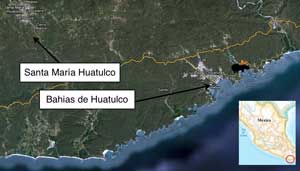On the final military checkpoint of my trip, the camouflaged officers asked me a familiar set of questions, starting with, “De donde viene?” Where are you coming from? I’m from Santa Barbara, California, I told them — heading to Huatulco, which is just a few miles away. After getting the thumbs up, I drove into town with the curious anticipation of arriving after 5,000 miles and three months of travel. That was slowly displaced by a peculiar feeling. From what I could see, I had come full circle, and two realities were merging.
The wide boulevards had center dividers, the lawns and trees were neatly groomed. Missing from view were packs of yelping dogs, iconic of most towns I’d seen in Mexico; or makeshift signs made out of car tires. Generous parking lots were in front of shiny stores. Everything looked so organized and easy to find. … I couldn’t help thinking, “This looks like my brother’s neighborhood in Aliso Viejo.” It was like a sliver of Southern California’s Orange County dropped into tropical Mexico.
Near the ocean, the well-designed architecture surrounded by picturesque bays and foliage reminded me of fancy Laguna Beach. I half-expected to see palm trees lining the waterfront sidewalk (pruned for public safety), with girls in bikinis playing beach volleyball. Alas, there were none to make this strange fantasy complete.
The godfathers of Huatulco tried to mimic the American dream. Yet, that wasn’t the reason I wanted to come here to do research; I came here because they aspired to create an ecologically sensitive destination.
The government agency Fonatur, in charge of developing tourism in Mexico, planned Huatulco (the area with tourist resorts is also known as Bahias de Huatulco) to best the faults of its cousins, Cancun and Los Cabos, which in turn had tried to best the faults of their uncle, Acalpuco. The uncle had grown like a hedonistic slob in the 1960s, spewing sewage and fomenting crime (although I hear it has improved since); the cousins were “master-planned” as ideal tourist cities to avoid pollution and social ill; but unfortunately the designers underestimated the creativity of the human ego. Trying harder, young Huatulco was meticulously planned for a better harmony of nature and society, back in 1987.

Huatulco has a balance of development and protected areas to ensure that its civilized sides don’t squelch the wild, attractive sides — the islets, sandy bays and lush mountains. To preserve wildlife habitats, a national park was established in 1998 with almost 12,000 hectares encompassing both ocean and lowland jungle. Waste water and solid wastes are managed by modern facilities.
On the social side, fair jobs and infrastructure improvements were set up to benefit the local community. The result of these and other efforts was the Green Globe certification for regional sustainable tourism; Huatulco is only one of three regions in the world with this credential (the others are Bali, Indonesia and Kaikoura, New Zealand).
Despite the “green” image, the number of visitors coming to Huatulco falls short of original expectations. The modern marina remains half-used, and several roads remain unfinished, which may one day lead to expansions. The downturn of tourism in Mexico hasn’t helped, following bad press (swine flu, drug cartels) and an American-European recession.
However, the reason for slow growth may be systemic, according to Paulino Jimenez, the director of the Institute of Tourism at the local Universidad del Mar. “Whereas the federal government built hotels in Cancun and Los Cabos to generate a critical mass of tourism and gave preferential interest rates to incentivize new developers, they did not do the same in Huatulco,” said Jimenez. “This was due to policies of liberal economics in the late ’80s. They still built the infrastructure [water, airport, sewer, roads] but didn’t offer special loans and left the hotel construction to market forces. And the market did not buy in as hoped for.”
I asked if Huatulco would be better if it grew faster. I wanted to get his opinion as a resident of the area.
“I like it this way,” he admitted, “But the investors aren’t getting the returns they hoped for. And the rate of immigration into the area, that is, new people looking for jobs, has been higher than the growth of jobs. The result is less investment, more unemployment and social unrest.” I reflected on this for a moment. Are investors and immigrants the equivalent of the “carrot and the stick” forcing growth? In other words, are investors like the carrot, waving dollar signs to lure development deals, and immigrants like the stick, threatening to hit with a population boom that can only be managed with constant growth? Interestingly, both groups are outsiders to the area.
In contrast, those originating from Huatulco reveal mixed emotions. Some want growth to create jobs for their families (especially since they need to compete with increasing numbers of people) but may also be resentful about that growth, particularly as it relates to their past. “We had no choice, we had to move,” José Rodríguez, a Mixteco who sells artwork on the street, told me. He was referring to the federal government’s relocation of coastal settlements to the inland town of Santa María Huatulco, an effort to create a blank slate for tourism development. “Some people did well [since the relocation],” he added, “but others … not so much.” His paintings of colorful birds and plants on bark paper were proudly displayed on the sidewalk.

According to Ludger Brenner, an expert on regional tourism development, Huatulco’s design does not make it immune to the problems of large resorts. In his article “State Planned Tourism Destinations: The Case of Huatulco,” Mexico, Brenner notes that despite changes in planning, the problems of “social segregation, burgeoning shantytowns and the formation of economic enclaves could not be solved. Therefore, not even small-scale and technically well-planned luxury resorts can be considered as a means of initiating socially sustainable regional development, which suggest the need for a more radical re-orientation of tourism policy.”
In fact, Huatulco’s Green Globe certification was in danger of being revoked last year, in part due to a lack of cohesion between governmental policies and the needs of the local population.
Different models of tourism do exist, such as geo-tourism and and community-based tourism, as described in a recent Miller McCune article, “Can Tourism be Sustainable?” For the most part, these models do not have the scale needed to support large investments in infrastructure. This has created a catch-22: how do communities develop tourism facilities, which are often located in ecologically (and socially) significant areas, without relying on outside financing that tends to overlook local needs?
There is no answer yet to this problem, but some good “bandages” are emerging. In late 2008, the United Nations and Rainforest Alliance released the Global Sustainable Tourism Criteria, an expert consensus on what constitutes a sustainable tourism operation (Green Globe has recently incorporated these standards). These standards represent “the minimum that any tourism business should aspire to reach in order to protect and sustain the world’s natural and cultural resources while ensuring tourism meets its potential as a tool for poverty alleviation.” Mandating such standards would be a big step forward for governments that are serious about using tourism as a positive force.
In fairness, Huatulco is doing its part in this evolution. Their effort in applying standards such as Green Globe to a large scale is commendable. The pitfalls encountered are inherently due to their model of growth: a master-planned resort with enormous investments. I would hope that “next-generation” resorts (such as one planned in Escuinapa that I reported on earlier) have an even stricter set of standards.
Better yet would be to reinvent the ballgame. Imagine a development that is low-resource intensive, using a fraction of the water and electricity, and waste is processed on-site or nearby. If massive investment were not needed to create dams, to build power plants and to install centralized sewage systems, obsessive growth to repay investors might not be required. (Yes, we’re dreaming here!) Like the analogy of the oak tree, slow and organic growth with clear rules like zoning, instead of explosive bamboo shoots with controversial results, would be a better option for developing small communities and virgin coastlines.
(Besides low-resource technology, which is just becoming commercially viable, there are at least two other limiting factors. One is transportation. Until someone invents a teleport machine, roads and airports are still necessary. A second limiting factor is national debt. This creates a drive for foreign currency, which requires fast growth for an international market. That has been a major imperative of Mexico’s tourism policy.)
In the meantime, the status quo is to improve what we already have, by “greening it” instead of “reinventing it.” Sure enough, Huatulco has managed to protect some amazing landscapes and to create clean and safe cityscapes. Yet as a global society, we are obviously still too enamored with the American dream of wide boulevards and manicured gardens, which are resource intensive and require large amounts of capital, both financial and natural.
While money can always be printed, resources are harder to reproduce. Hence, natural capital may ultimately become the limiting factor that makes the low-resource ballgame the only game in town.





